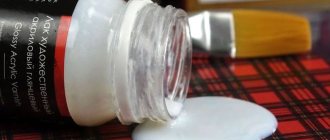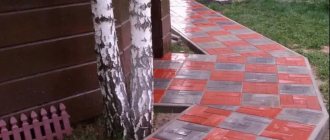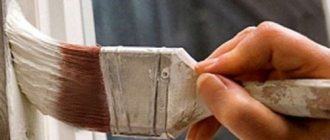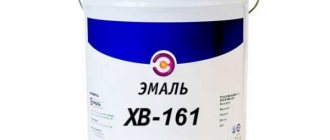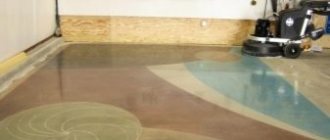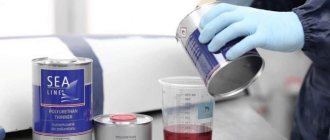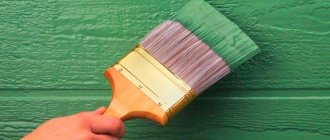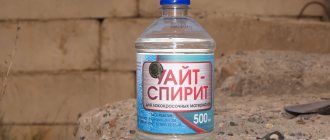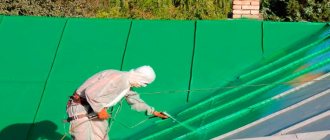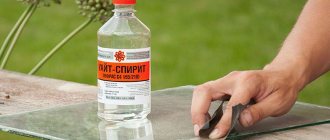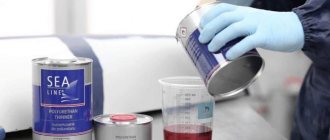The modern construction market is constantly updated with new innovative materials. These include rubber paint, which has recently appeared on sale. It was created as an alternative to existing paint and varnish products.
What is rubber paint?
The material, whose consistency resembles mastic, does not contain rubber in its composition, but has properties similar to it, which is why it was named so. Rubber paint is a very plastic substance that, when dried, forms a durable coating similar to rubber. The product that is painted with it has the appearance of being covered with a thin layer of rubber.
Rubber paint composition
In the industrial production of this painting material, the following ingredients are used:
- Acrylate latex
. It makes the rubber coating durable - Coalescent
. This substance, acting as a plasticizer, promotes the formation of a strong foam after the paint dries. - Water
. It is used in the mixture as a solvent. - Antifreeze
. Gives the product frost-resistant properties. - Preservatives
. Thanks to their presence, liquid rubber paint is well preserved in a closed container; mold and mildew do not form in it. - Pigments
. They give the paint the required color.
Rules
There are simple rules for applying rubber that must be followed:
- A total of 5-7 layers are applied to each disc, with one application;
- It is better to apply the first layer by spraying;
- On the second pass, pay more attention to the corners and spokes;
- Subsequent passes are needed to increase the thickness and strength of the layer;
- Rubber is applied at angles of 60-90 degrees;
- Damaged areas with noticeable defects can be passed separately several more times to smooth them out and hide them under the thickness of the layer;
- Drying of the first layer is about 15 minutes, subsequent layers are 30-40 minutes;
- It is recommended to dry a fully treated wheel for another day.
Unsuccessfully applied rubber can be carefully torn off from the surface, without harm to it, and applied again. I have everything, my friends. Now you can handle the coating of rims with rubber yourself, decorating your car. I recommend reading my article “Do-it-yourself repair and painting of stamped wheels.” Subscribe to updates on the site and share the link with your friends.
Characteristics of rubber paint
This painting material also has other names: liquid vinyl, plastidip. The complex composition of this paint described above determines its high performance characteristics:
- Excellent adhesion
to a wide variety of surfaces: asphalt, cement, galvanized iron, wood. - High vapor permeability
. Condensation does not form under the paint layer. - Perfectly smooth coating
. There are no bald spots on the painted product. - Resistance to temperature fluctuations
. The paint can be used in the range from -50 to +60ºС. - Excellent protective properties
. Liquid paint protects the painted product from chips, scratches, and the influence of aggressive reagents. - Anti-slip effect
. The surface of hardened liquid rubber has a reduced coefficient of friction, which is especially important if this material is used as a floor covering. - Durability
. Rubber coating can be used without repair for about 10 years. - Environmental friendliness
. Neither during application nor during operation, this material does not emit substances harmful to human health, since it does not contain any chemical solvents.
How much should I buy?
If you paint 4 discs with a spray, how many cans will be needed in total? Many authors forget to answer this crucial question. Meanwhile, you need to take into account that the coating is applied in 5-7 layers. The options are:
- 2 cans of spray should be enough for 4 discs if the coating is 5-7 layers;
- If you want a final layer of a special color, then add another can of final coating, the previous layers will serve as a strong base;
- For large and patterned rims, it is recommended to take one can per wheel.
To summarize, I will say that it all depends on your skill and the number of layers applied; for a car - a passenger car, you need a maximum of 4 bottles of spray.
What is rubber paint used for?
Due to its high quality characteristics, rubber paint is considered a very practical coating, which is successfully used in a wide variety of painting jobs:
- Finishing of house facades and roofs
. Liquid rubber paint perfectly penetrates into the smallest cracks that inevitably appear on concrete, and its uniform distribution visually aligns the walls, giving them a rich color. - Treatment of concrete pools
. Rubber paint for concrete does not absorb water, so it is successfully used as a waterproofing coating in the construction of artificial reservoirs. - Car painting
. Aerosol rubber paint for metal or plastidip used for these purposes gives the parts and body of the car anti-corrosion properties. - Painting wooden elements
. Rubber paint for wood contains substances that prevent the formation of mold, and therefore is often used for painting enclosing structures. - Applying road markings
. Due to its durability and resistance to damage, this paint is an excellent option for covering areas and roads. - Interior work
. This material is suitable for painting floors, for example, on a loggia, balcony, or garage.
Pros and cons of rubber paint
Like any paint and varnish mixture, liquid rubber has its advantages and disadvantages. First, let's look at the significant advantages:
- At a humidity of no more than 65% and room temperature, rubber paint will dry in about 2 hours, unlike other coatings: some of them may require about a day.
- The surface treated with rubber paint is resistant to ultraviolet radiation, abrasion, and impact.
- Painted products are elastic; they do not lose their original appearance either when heated or when cooled. In addition, they may be subject to deformation, but this will not affect the strength of the paint layer in any way.
- You can use rubber-based liquid paint not only outdoors, but also in a closed room, since the material is odorless.
- It is easy to apply rubber liquid paint, and you do not need complex devices for this: it is sprayed from a can or applied with a roller or brush.
- The cost of this material is quite affordable.
Experts consider one of its disadvantages to be one of the disadvantages of liquid rubber paint: if you do not carefully prepare the working surface and debris and dirt remain on it, or if you apply the material in a very thick layer, the paint may subsequently swell with bubbles or even peel off completely. When painting, you should strictly follow the instructions for applying such a coating.
Types of liquid rubber
The cost of the product varies, it all depends on the manufacturer. There are budget coverage options, and there are very expensive ones. You can cover the rims (and other elements) of the car yourself, or you can contact a service center where they will do everything for you.
The most popular rubber is in a can. They are much cheaper than canned ones and come in a wide variety of colors and textures. Plasti Dip is considered the market leader; it is an American brand. In addition to sprays, manufacturers package liquid rubber in cans or buckets.
Purchasing buckets or cans is more economical, however, for application you need special equipment - a spray gun and a compressor, or an electric sprayer. It is not recommended to apply it with a brush; it will not create a smooth and uniform layer.
The can version is more suitable for covering the entire bottom of the car, or the entire body. That is, for large volumes of coverage. For rims, a spray is sufficient.
The most accessible, well-known and popular types of liquid rubber are:
- Plasti Dip. Produced in America, in the form of 400 ml cans. In addition to the standard color palette, there are special ones, for example, mother of pearl, metallic or chameleon. It is very easy to remove and apply. Suitable for painting and as protection against scratches or chips.
- Air Dip. Analogue of the American product, Chinese release. The scope of application is the same, but Chinese products are limited in colors and variety of textures. It has no glossy shades at all.
- Liquid Rubber Coating. The cheapest coverage option. The structures are only matte, but the color palette is unlimited. Also produced in 400 ml cans.
Rubber paint - colors
The modern paint and varnish market offers such a product in various colors. Among craftsmen, universal products in black and white are considered the most popular. From different manufacturers, rubber-based paint can have, in addition to these two main ones, from 5 to 17 different shades. In some cases, the tone required by the buyer is prepared to order. Car paint can have an unusual glowing effect, be pearlescent or shimmering, glossy or matte. For facade work, rubber colored paint interspersed with crumbs is produced.
Is it possible to tint rubber paint?
Often, consumers purchase rubber paint that is ready for use. However, there are also various colors for it on sale. They are mixed with the original material, and the white rubber paint acquires the most original shades of varying degrees of brightness and intensity. This tinting increases the decorative effect of the treated coating and significantly expands the scope of application of rubber paint.
Sale of Plasti Dip, Rubber Paint and Color Dip in Moscow.
At the moment, we cooperate with leading manufacturers of rubber paint, who supply their products to Moscow and other cities of Russia. You can buy Plasti Dip and Color Dip paint at retail or wholesale. When purchasing rubber paint Ruber Paint and Color Deep in bulk, the price is significantly lower than the retail price. For regular customers of Plasti Dip liquid vinyl, the cost of cans, buckets and canisters is also reduced.
Liquid rubber for cars Plasti Dip, Rubber Paint and Color Dip are sold in Moscow with the possibility of delivery or pickup. There is a large assortment of matte and glossy rubber paint in various color shades on sale. You can also buy related products from us that will help you carry out high-quality painting of car parts: solvent, degreaser, wipes and much more. When purchasing several cans or buckets of any color, discounts are provided on the price of liquid vinyl and delivery.
Rubber paint rating
Before choosing rubber paint, you should read the review of the most popular types of these products, compiled based on customer reviews:
- FARBEX
. This universal rubber paint is used for painting a wide variety of surfaces, indoors and outdoors. - Dali
. The product creates a matte surface that is not afraid of dust and various mechanical influences. Thanks to this, Dali rubber paint is used for painting roofs, facades and plinths of buildings. - Master Good
. This paint is used for both interior and exterior work, but is not recommended for painting areas subject to abrasion: paving slabs, benches. - Siltex Paints
. This matte paint is often used for painting roofs. - Rezolux Universal
. An excellent material for decorating concrete surfaces. - Super Decor Dubber
. This paint is used to waterproof swimming pools, bathrooms, and showers. - LAREX
. This automotive paint protects your car from chips, harsh chemicals and rust. It is used to paint the car body and decorate smaller parts: wheel rims, radiator grille.
Preparation
Any driver who has already dealt with painting wheels knows that such work is carried out indoors without dust and debris, which easily stick and spoil the appearance. Wheel rims also require preparation before coating:
- It is necessary to clean the discs from dirt, dust, oil flows and debris.
- The treated surface is dried and degreased with a solvent.
After this, you can spray the rubber. If the liquid is sprayed unevenly, it is not recommended to rub it with a rag so that the fibers do not get on the coating. It is better to buy anti-silicone, which is freely sold in any spare parts store.
Rubber paint in cans
An alternative type of automotive paint or vinyl film today is plastidip in the form of a spray. This aerosol rubber paint is an additional protection for vehicle structures. Its peculiarity lies in its affordability, quick and convenient application and easy removal. For high-quality painting of various parts of the car, you will need to spray up to 4-5 layers. The paint dries completely within 12-24 hours.
Why are discs covered?
What does such coverage provide, is there any benefit or is it a collective farm show-off? This type of tuning is considered not a simple decoration:
- Rubber provides additional protection against moisture, scratches and chips on metal. Scratches on the disc occur from pebbles flying from under the wheels;
- This is a design method of giving a car a unique style, not prohibited by law;
- A good way to hide disc defects, scratches, chips, small dents, and give them a new life;
- Applying a spray from a can will cost less than replacing discs or contacting a service center for painting.
How to paint with rubber paint?
You can paint any surface with such a liquid composition either manually or using professional sprayers. Before work, you need to test the paint to determine the thickness of the composition, its color and drying speed. According to the recommendations of experts, the use of rubber paint should be in the following sequence:
- Thoroughly clean the surface from dirt, rust and dust. If there are greasy stains, they must be degreased with any solvent.
- The porous base must be treated with a primer, and the painted glossy base must be sanded.
- Rinse the cleaned surface with water and dry thoroughly.
- Mix the paint well using a construction drill with an appropriate attachment.
- We apply the first layer of paint using a roller or brush, although you can also use a spray gun.
- Each subsequent layer should be applied only after the previous one has completely dried (after about 2 hours).
Main advantages
The advantages of rubber paint include the following:
- low price;
- ease of use (even a beginner can apply the aerosol);
- immunity to elevated temperatures;
- long service life;
- protection of the surface from deformation and rust;
- variability of color solutions;
- protection from negative environmental influences;
- the ability to easily remove the coating;
- high waterproofing properties.
Quite often, applying liquid rubber makes it possible to eliminate the need for a separate body cladding. If the aerosol is applied according to the manufacturer's recommendations, the result is a completely flat surface.
A nice bonus is the possibility of partially restoring the applied layer; this may be necessary in case of a minor accident. Local restoration cannot be carried out on vinyl film.
How to dilute rubber paint?
Those who have not worked with such a painting material before may be wondering how to dilute rubber paint. If the rubber-based mixture is too thick, experienced craftsmen recommend diluting it with water or soil. In this case, the amount of liquid added cannot exceed 10% of the total volume of rubber paint, since a more liquid composition loses its properties. Water should be added in small portions, constantly stirring the mixture. It is strictly forbidden to dilute such paint with solvents, as this will make it unsuitable for work.
How to remove rubber paint?
If it becomes necessary to remove the rubber coating, you should know that this material does not react with any substances, so it will not be possible to remove it with acetone, gasoline and other solvents. This rubbery elastic paint can only be removed with hot water. You should wet the area well with it, and then try to remove the layer of paint. In some cases, it comes off easily, like a film, while in others you will have to rub the area with a sponge soaked in hot water.
Dyeing technology
First of all, it is necessary to prepare the surface by cleaning it from old coating, dirt and grease. Remove from it all hanging elements and structural parts that will interfere with painting. If necessary, repair large cracks or potholes with cement or putty. You can pre-prime it with a composition suitable for a specific type of coating, and treat smooth areas with sandpaper, then rinse with a soda solution and wait until it dries completely.
Before use, the paint must be thoroughly mixed and, if necessary, slightly diluted with water. It is best to apply it at temperatures from +5° to +30° manually or using a spray gun on a dry surface. It is better not to carry out work during rain, in extremely hot weather or in direct sunlight.
The paint must be applied in a thin layer, stirring from time to time. If one layer is not enough, you can do two or three, allowing time between them for drying.
How to make your own rubber paint?
Such a painting material, which has all its characteristic features, is produced exclusively in industrial conditions, but you can try to make approximately the same paint yourself. To do this you need to mix the following components:
- PVA glue – 50 g;
- water – 1 tbsp. spoon;
- color scheme of the desired color - 3-5 caps.
All these components are thoroughly mixed until a uniform shade is achieved. After this, the matte acrylic rubber paint is ready for use. Above we found out how long it takes rubber paint to dry, so if necessary, after 2 hours the painted surface can be treated with varnish. This will make it more durable and give the product a beautiful glossy shine.
